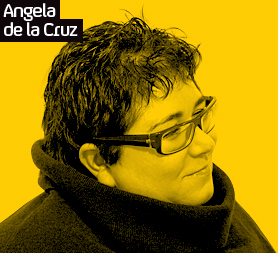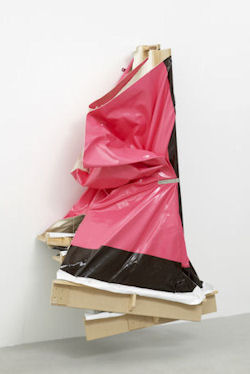Turner Prize 10: Angela de la Cruz
Angela de la Cruz creates paintings using the language of sculpture and vice-versa, creating works with an element of slapstick comedy which strike at a deeper emotional tension.

Angela de la Cruz was born in Spain in 1965. She moved to the UK in 1987 and studied at Goldsmiths College, London, in the early 1990s before attending the Slade School of Art. She still lives and works in London.
De la Cruz has been nominated for Turner Prize 10 in recognition of her solo exhibition, After, at Camden Arts Centre in London. She uses painting and sculpture to create work with a sense of tension, emotion and fun.
De la Cruz asks “when is a painting not a painting?” After breaking the stretchers of her canvases as a student, she became intrigued by the idea of “liberating” a canvas from its boundaries, allowing it to take on a third dimension.
Her most recent work, although deformed and smashed, displays a luxurious, glossy form. Deflated IV 2010 is freed from the stretcher altogether, and hangs like a shiny, wet coat on a hook.
3 Minute Wonder on Channel 4 until 9 December (Courtesy: Tate Media)
De la Cruz takes a playful swipe at consumer culture with her Clutter series which examines the concept of excess production by “painting too many”. Yellows, fuschias, pinks and military greens find their way into these crumpled monochrome paintings via the world of high-fashion. The Clutter works are made up from existing canvases, morphed into a new context.
I like the idea of it being a bit broken and that something was kind of missing. Angela de la Cruz
Clutter I 2003 is made up of old layers of broken paintings. The series pulls in newspaper cuttings from the Iraq war and Madrid bombings and culminates with Super Clutter XXL (Pink and Brown) 2010, a contorted canvas with multiple folds revealing glimpses of a former life.
De la Cruz, who suffered a serious stroke in 2005, toys with ideas of brokenness, frailty and new beginnings while delighting in a comedy element and the notion of paintings with a life of their own: a determination to behave badly.
More on Angela de la Cruz from Turner Prize 10

(Super Clutter XXL (Pink and Brown), 2006. Courtesy: Lisson Gallery london. Photo: Tate Photography)
‘I like the idea of paintings behaving badly’
“I think it’s more humorous than anything else. When they are completed, a proper painting, they are kind of sacred. But once they get broken they are not sacred any more. I realise I’m opening up to a lot of possibilities.
“When I go to the studio I rely on quite a lot of people, but I also think before about my work and the work they have to do.
“I used to work with a team of people before my stroke, but the differentce, I guess, is I was quite a hands-on artitst which I can’t do at the moment.
“I like the idea of it being a bit broken and that something was kind of missing, but still hanging on the wall by mere chance.
“The titles are very figurative, they describe the work. It’s a sculpture using the language of painting and vice-versa. It’s a painting and a sculpture, that’s it.”
“I like slapstick and silly humour. I like the idea of paintings behaving badly.”
'Work infused with the artist's wicked sense of humour,' writes Matthew Cain
When I first saw the work of Angela de la Cruz, I was struck by the sense of violence it seemed to embody.
And "embody" is a word I choose carefully; each of the artist's canvases has a strong sense of the human body and that body being broken. But there's also a sense of liberating the paintings from the constraints of the canvas.
And the result is work which invites us to ponder our physical presence in the world. This reading is often encouraged by the figurative titles chosen by the artist - Flop, Damaged, Ripped, Shrunk, Limp, Full, Stuck.
Given that it speaks to me so strongly of the human body, one of the things that fascinates me most about the work of Angela de la Cruz is how little it has changed since the stroke which left the artist unable to speak clearly and confined to a wheelchair.
You might expect a sense of frustration at the physical condition to creep in here or a more explicit sense of liberation from physical constraint through the work. None of this seems to have appeared.
Yet what the work has done is take on a stronger emotional resonance to anyone aware of the artist's biography. And I find this quite moving.
This is also work infused with the artist's wicked sense of humour. De la Cruz says that her comic heroes are Buster Keaton and Charlie Chaplin but what strikes me is that when this inspiration is transformed into finished work through the artist's own creative processes, what emerges is a far darker, more subversive humour.
When juxtaposed with her often bright colours, the result is something quite unique and instantly recognisable.
Perhaps the last word should go to the artist herself. "Paintings behaving badly" is how she describes her work. I couldn't have put it better myself.